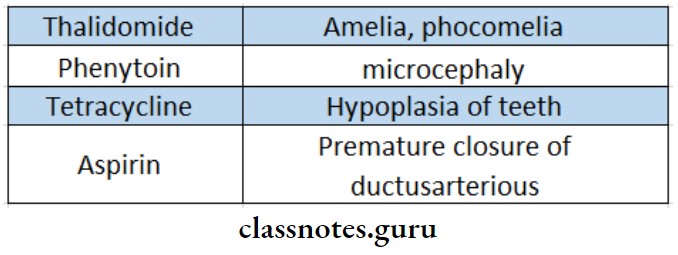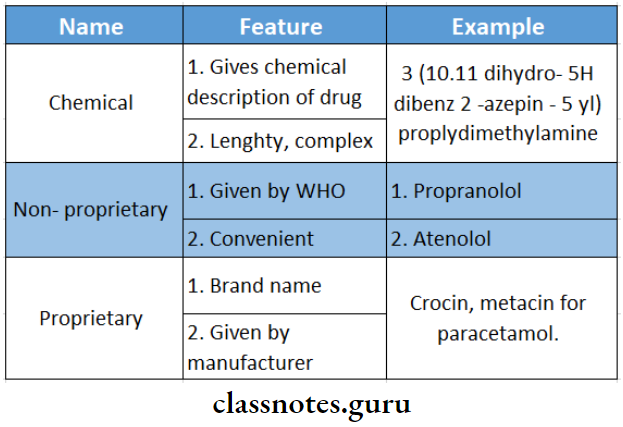Adverse Side Effects Important Notes
1. Cummulation
- Accumulation of a drug in the body if the rate of administration is more than elimination resulting in toxicity
- Example: digitalis
2. Tolerance
- Requirement of a large dose of a drug to produce a given response
- It may be natural or acquired
Adverse drug reactions questions and answers
Read And Learn More: Pharmacology Question and Answers
3. Tachyphylaxis
- It is the rapid development of tolerance
- The dose of the drug is repeated in quick succession resulting in a marked reduction in response
- This is seen with directly acting catecholamines
- Example: ephedrine, tyramine, amphetamine, 5-HT
4. Idiosyncrasy
- It is the unpredictability of drug reaction due to other than immune reactions
- It is genetically determined
5. Side effect
- It is the undesired effect produced by the administration of a therapeutic dose of a drug
6. Teratogenic drugs
- Drugs that cause fetal malformations when taken during the first trimester of pregnancy
- They are:

7. Dependence
- A state, psychic and
- Sometimes also physical results from the interaction between a living organism and a drug characterized by a compulsion to take the drug
- Drugs causing psychic and physical dependence
- Barbiturates
- Alcohol morphine
- Drugs cause more psychic but less physical dependence
- Amphetamine
- Opioid antagonist
- Drugs causing only psychic dependence
- Cocaine
- Caffeine
- Cannabis
Drug side effects MCQs with answers
Adverse Side Effects Long Essays
Question 1. Write in detail about Drug Toxicity in men.
(or)
Adverse drug reactions.
Answer:
Drug Toxicity Definition:
- WHO has defined an adverse drug reaction as any response to a drug that is noxious and unintended and that occurs at doses used in men for prophylaxis, diagnosis, or therapy.
Adverse drug reactions Types:
1. Side-effects:
- These are unwanted but unavoidable pharmacodynamic effects of drug occurring at therapeutic doses. They are predictable and common.
- Example: Sedation caused by promethazine
2. Secondary effects:
- Corticosteroids cause immunosuppression which leads to latent TB.
3. Toxic effects:
- These are results of Examplecessive action of the drug due to prolong usage or overdosage.
- Overdosage may be accidental, suicidal absolute, or relative.
- They are predictable & dose related.
- Organs affected commonly are CNS, CVS, kidney, liver, lung, skin & blood-forming organs.
- Poisoning can occur when the dose of the drug crosses the therapeutic index.
Adverse drug reactions Treatment:
- Maintain airway by adequate ventilation.
- Maintain BP and pulse rate.
- Terminate the Exampleposure to the drug.
- Exampleposure of the patient to fresh air.
- Gastric lavage is done in case of ingested poison.
- Preventing absorption of ingested poisons by use of suspension of 20-40 g of activated charcoal in 200 ml of water.
- Inducing. diuresis.
4. Intolerance:
- It is a characteristic toxic effect of a drug at a therapeutic dose.
- Indicates a low threshold of the individuals to the action of the drug.
- Example: Single dose of triflupromazine induces. Muscular dystonia in some individuals.
5. Idiosyncrasy:
- It is genetically determined abnormal reactivity to a chemical.
- It is a type of intolerance of some patients to specific drugs.
- Some drugs without any genetic cause lead to ad- verse effects.
- Such drugs are also included in it.
- Example: Chloramphenicol causing agranulocytosis.
- Some patients may be highly sensitive to even low doses while others may be highly insensitive even to high doses of the drug.
6. Drug Allergy:
- The drug can induce cell-mediated or humoral-mediated immunity.
- The drug or its metabolite acts as an antigen and induces an immunological reaction.
- Organs affected by it are the skin, respiratory tract, gastrointestinal tract, blood and blood vessels.
Drug Allergy Types:
- Type 1 – Anaphylactic reaction.
- Type 2 – Cytolytic reaction
- Type 3 – Arthus reactions
- Type 4 – Delayed hypersensitivity reaction.
7. Photosensitivity:
- It is a cutaneous reaction resulting from drug-induced sensitization of the skin to UV radiation.
Adverse effects of medication short notes
Photosensitivity Types:
- Phototoxic.
- Drug or its metabolite accumulates in the skin, absorbs light, and undergoes photochemical reactions followed by photobiological reactions, resulting in local tissue damage and sunburn.
- Example: Tetracyclines.
- Photoalergic.
- Drug or its metabolite induces a cell-mediated immune response on Exampleposure to UV resulting in contact dermatitis.
- Example: Sulphonamides.
8. Drug dependence/Addition:
- Drug dependence.
- It is a state of compulsive use of drugs in spite of the knowledge of the risks associated with its use
- Example: Alcohol.
- Addiction.
- It is the dependence of a person on a drug to an Exampletent that influences the behavior and mood of the person.
- Example: Barbiturates.
9. Teratogenicity.
- It is an ability of a drug to cause fetal abnormalities when administered to a pregnant lady.
- Depending on the stage of pregnancy during which the teratogen is administered, it can produce various abnormalities.

- Example: ACE inhibitors can cause hypoplasia of organs.
10. Drug withdrawal reactions.
- Certain drugs on sudden cessation result in adverse effects.
- It may cause a worsening of the clinical condition.
- Example: Acute adrenal insufficiency may be precipitated by abrupt cessation of corticosteroid therapy.
11. Carcinogenicity and mutagenicity.
- It refers to the capacity of a drug to cause cancer and genetic defects.
- It generally takes several years to develop
- Example: Anticancer drugs, and radioisotopes.
12. Drug-induced diseases – iatrogenic diseases.
- They are functional disturbances caused by drugs that persist even after the causative drug has been withdrawn.
- Example: Hepatitis by isoniazid.
Pharmacovigilance and ADRs questions
Adverse Side Effects Short Essays
Question 1. Anaphylactic reaction.
Answer:
It is the type 1 hypersensitivity reaction.
- It is the only type of allergic reaction that the dentist may have to treat by himself.
Anaphylactic reaction Mechanism:
The drug or its metabolite act as an antigen
↓
It induces the synthesis of IgE antibodies which get fixed on mast cells.
↓
On Exampleposure of the drug, antigen-antibody complExample is formed.
↓
It causes the degranulation of mast cells which results in the release of
histamine, leukotrienes, prostaglandins, and platelet-activating factor
↓
Results in clinical manifestations of anaphylaxis.
Anaphylactic reaction Clinical features:
- Bronchospasm.
- Laryngeal edema.
- Hypotension.
- Urticaria.
- Itching.
- Angioedema.
- Rhinitis.
- Anaphylactic shock.
- Example: Penicillin, cephalosporin, lignocaine, procaine, etc.
- Skin tests are carried out to detect it.
Question 2. Drug nomenclature.
Answer:
A drug can have three names.
- Chemical name.
- Non-proprietary name and
- Proprietary name.

Adverse drug reactions important exam questions
Adverse Side Effects Short Answer
Question 1. Drug resistance.
Answer:
It refers to the unresponsiveness of a microorganism to an antimicrobial agent.
Drug resistance Types:
- Natural resistance.
- Some microbes have always been resistant to certain antimicrobial agents.
- Example: Gram-negative bacilli are unaffected by penicillin G.
- Acquired resistance.
- It is the development of resistance by an organism due to the use of antimicrobial agents over a period of time.
- Example: Gonococci resistant to penicillin.
Question 2. Drug cumulation.
Answer:
When the rate of administration is more than the elimination rate, the drug will cumulate in the body and causes toxicity.
Example: Prolonged use of chloroquine causes retinal damage.
- The sometimes cumulative effect is desired.
Example: Use of phenytoin in the treatment of epilepsy.
- Substances like lead can remain deposited in bone without producing toxic effects.
Drug cumulation Prevention:
- Stop drug administration.
- Select the proper route of administration
- Check liver and kidney function before and during administration.
Difference between side effects and adverse effects
Question 3. Teratogenetic agents
Answer:
- Drugs that cause fetal malformations when taken during the first trimester of pregnancy
- They are:
- Thalidomide
- Amelia, phocomelia
- Phenytoin
- Cleft lip and palate, microcephaly
- Tetracycline
- Hypoplasia of teeth
- Aspirin
- Premature closure of ductusarterious
Common adverse effects in nursing pharmacology
Viva Voce:
- Toxicity occurs at overdosage or prolonged dosage
- Side effects occur at the therapeutic dose
- Idiosyncrasy is genetically determined
- The first trimester is the most vulnerable period for teratogenicity
